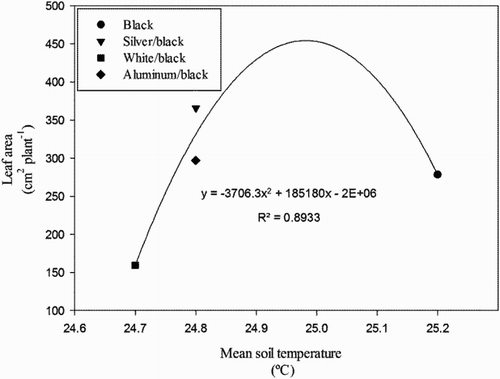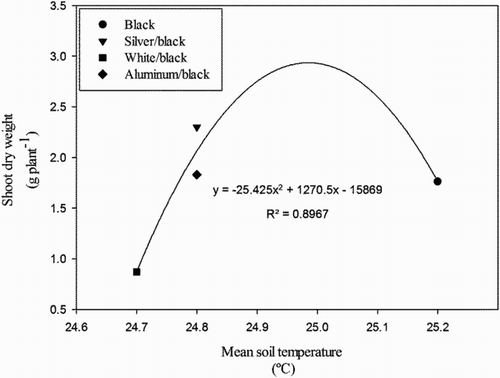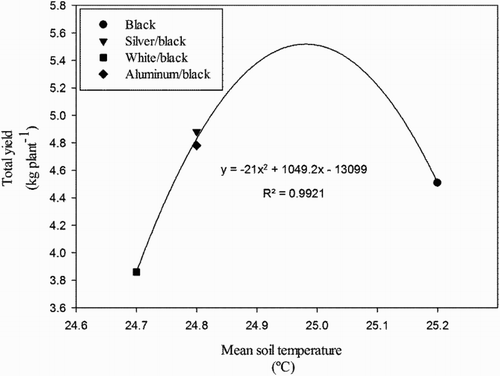ABSTRACT
Purpose: The aim of this study was to realize whether soil mulching, with different plastic mulch colors, is a suitable practice for the culture of pickling cucumber.
Materials and Methods: The crop was cultured or not with black, silver/black, white/black, and aluminum/black plastic films, treatments were evaluated in randomized complete block design, to determine their effect on soil temperature, gas exchange, nutrient concentration, growth, and fruit yield.
Results and Conclusions: Black, silver/black, and aluminum/black plastic mulches were higher (p ≤ 0.05) in plant height, leaf area, and shoot dry weight than bare soil at 15 days after sowing, whose results were similar than using white/black film. Maximum, minimum, and mean soil temperatures were higher with all plastic mulches except for aluminum/black, in which the maximum soil temperature was similar to the one in bare soil. There was no difference in net photosynthesis and there was very little difference in nutrient concentration between plants in plastic mulches and plants in bare soil; however, early and total yield showed a higher (p ≤ 0.05) yield in all plastic mulches, and lower with bare soil and white/black plastic mulch. Our results confirm that soil mulching impacts the pickling cucumber yield. We suggest a carefull selection of the color plastic mulch.
Introduction
One of the main goals in agriculture is to obtain higher yields per unit area; a higher amount of biomass per unit area is desirable in order to increase productivity maximizing solar energy fixation. This is normally achieved using high plant densities, although some horticulturists prefer to optimize the yield per plant to increase crop yield while maintaining plant densities low and facilitate cropping and harvesting activities. The use of lower plant densities and plastic mulch modifies the microclimate in the crop environment, accelerates growth, and improves product quality (Tarara Citation2000).
Current knowledge on the chemical properties of plastics is advanced enough to understand its performance (Ham et al. Citation1993), but to achieve satisfactory crop performance it is desirable first to define the optimum microclimate around the plant. Black plastic mulch may induce detrimental effects on crops if the optimal soil temperature is exceeded, which reduces crop growth and yield, whereas a decrease in soil temperature in the same growing season and in the same crop may have positive effects on growth and yield if clear plastic mulches are used. For example Díaz-Pérez (Citation2009) reported that different colored plastic mulches in broccoli promoted growth and crop yield during the spring, but the effect on crop yield was lower in the fall because soil temperatures tended to be lower. Optimized crop production can be achieved if the best microclimate for the plants is defined by testing different colored plastic mulches. Clear and black plastic mulches (Manrique Citation1995) were reported to have a negative effect on emergence and yield in a potato crop in a tropical region due to the excessive soil temperature generated by the plastic mulches; potato yield was more affected when exposed to excessive soil temperatures when using black plastic mulch than when using clear plastic mulches (Ibarra-Jiménez et al. Citation2008). These and other similar reports show the importance of soil temperature in the response of the crop to the color of the plastic mulch. However, there is scarce information on pickling cucumber cultivation using colored plastic mulches. The present study was carried out to determine the effect of colored plastic mulches on soil temperature, gas exchange, nutrient concentration, growth, and fruit yield in pickling cucumber crop.
Materials and methods
The experiment was conducted in the region of Saltillo (Coahuila, Mexico), coordinates 25° 27′ N, 101° 02′ W, at 1510 m above sea level. Beds were separated by 1.8 m, and the distance between plants was 0.3 m. Drip irrigation tape was manually placed along with emitters at a 0.305 m separation, and irrigation water flow was 0.98 L h−1. Plastics mulches were manually placed; the differently colored plastic mulches (black, white/black, aluminum/black, silver/black) were arranged in a randomized complete block design with three replications, and compared to bare soil. The experiment used 1.2 m wide and 0.03 mm thick plastic films (Chesterbrook, PA, USA). Seeds of pickling cucumber cv. SMR 58 were manually planted. The cucumber was staked using wooden poles (height 1.6 m from the soil level set 2.5 m apart within the bed and galvanized wire (caliber 1.2 mm) at 0.20 and 1.5 m above the soil surface). These wires were used to place a trellis for the vertical growing of the plants.
Irrigation was performed when tensiometers (Irrometer, Riverside, CA, USA) readings indicated 30 centibars. NPK fertigation was applied at a rate of 225-120-395 kg ha−1 during the growing season.
Soil temperature was measured every ten seconds at a 10 cm depth in the center of the bed using 0.6 mm diameter copper thermocouples connected to a multiplexer and a data logger (CR850 Campbell Scientific, Logan, UT, USA). Daily mean, maximum and minimum soil temperatures were recorded from seeding to harvest day.
Leaves and stems were harvested at 15, 30, and 45 days after seeding (DAS), and leaf area was measured using an LI-3100 leaf area meter (LI-COR, Lincoln, NE, USA). Leaves and stems were dried in an oven at 70°C for 72 h to determine shoot dry weight.
Photosynthesis was measured using an LI-6200 portable photosynthesis system (Lincoln, NE, USA) at 15, 45, and 75 DAS using the fifth leaf from the top on clear days between 12:00 and 14:00 h. Calcium (Ca), magnesium (Mg), copper (Cu), iron (Fe), manganese (Mn), and zinc (Zn) nutrient concentrations were determined on fully expanded young leaves sampled at 75 DAS. Leaves were washed in distilled water twice and bagged before placement in an oven at 70°C; once the plant parts were dry, they were ground to pass a 40-mesh screen with an A-10 analytical mill (Tekmar, Cincinnati, OH, USA). Nutrients in plant sample acid digests were determined by inductively coupled plasma emission spectrophotometry.
Harvest started at 55 DAS and was carried out three times a week for 30 days; the yield obtained during the first ten days of the harvest was considered early yield.
Data were analyzed using PROC GLM with SAS 9.2 (SAS Institute, Cary, NC, USA) and means were separated according to Duncan’s multiple mean test (p ≤ 0.05).
Results and discussion
Plant height
Plants cultivated using silver/black and aluminum/black plastic mulches were taller (p ≤ 0.05) than plants seeded in bare soil on the three sampling dates (15, 30, and 45 DAS). Treatments using black and white/black plastic mulches resulted in similar plant heights as those observed in plants sowed in bare soil when measured at 30 and 45 DAS, but not at 15 DAS, when black plastic mulch plants were taller (). Taller plants as a result of the effect of plastic mulch use have been reported in potato crop (Hou et al. Citation2010) and baby corn crop (Mahajan et al. Citation2007). A relationship between mean soil temperature and plant height (R2 = 0.99) was evidenced (). The effects of mean soil temperature on other growth components such as diameter stem, leaf dry weight, stem dry weight, and plant dry weight have been similarly reported by Díaz-Pérez (Citation2010) in bell pepper, where a negative relationship between mean soil temperature and those variables was found; however, in the present study we found a positive relationship between mean soil temperature and plant height. The bell pepper study was developed in the state of Georgia, USA, whereas our study was carried out in the northeastern region of Mexico, under different environmental conditions and using different crops; nevertheless, mean soil temperature may still provide an explanation to changes in some components of plant growth which could be valid for both crops and both latitudes.
Figure 1. Relationship between mean soil temperature (ten-cm depth), under differently colored mulching films, and plant height in pickling cucumber.
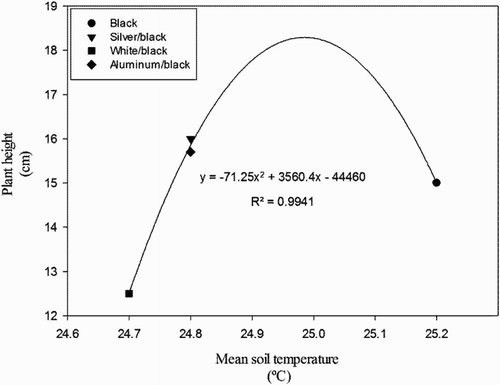
Table 1. Plant height, leaf area and shoot dry weight of pickling cucumber plants cultured in soil mulched with plastic films of different color.
Leaf area
Leaf area was higher (p ≤ 0.05) in plants with plastic mulch treatments in relation to plants sowed in bare soil at 15 and 30 DAS, except for plants under black/white plastic mulch treatment, in which leaf area was similar on both sampling dates. However, at 45 DAS, all treatments resulted in similar leaf areas (). Higher leaf area values due to the effect of plastic mulches have been previously reported in potato (Hou et al. Citation2010), as well as leaf area index in maize (Zhang et al. Citation2011). A relationship between mean soil temperature and leaf area at 15 DAS (R2 = 0.89) was found in the present study (). One of the main benefits of using plastic mulch is its positive effect on crop vegetative growth; this effect on leaf area resulted in higher total yield, represented by a numerical relationship between these two variables (R2 = 0.97) (data not shown). This positive relationship between leaf area and higher yield due to the use of plastic mulch has been previously reported in potato (Ruiz-Machuca et al. Citation2015) and in conventional cucumber (López-Tolentino et al. Citation2017).
Shoot dry weight
Plastic mulch treatments resulted in higher (p ≤ 0.05) shoot dry weight as compared to results from bare soil at 15 and 30 DAS, except for white/black plastic mulch, in which shoot dry weight was similar to the bare soil at 15 DAS. At 45 DAS, all treatments resulted in similar shoot dry weight (). All treatments tended to result in progressively increasing shoot dry weights. Higher shoot dry weight values due to the effect of plastic mulch use have also been found in tomatillo (Díaz-Pérez et al. Citation2005), and tomato (Martin-Closas et al. Citation2006). The present study found a relationship between mean soil temperature and shoot dry weight (R2 = 0.89) (), as well as a relationship between shoot dry weight at 15 DAS and total yield (R2 = 0.99) (data not shown). We also found an association between shoot dry weight and total yield at 30 and 45 DAS, in which R2 values tended to decrease (data not shown); which suggests that changes in shoot dry weight are due to the positive effect of the plastic mulch, especially at the early stages of pickling cucumber growth.
Leaf nutrients in plants
Analyses of nutrient contents indicated that Mg, Fe, Mn, and Zn contents were similar with and without plastic mulch treatment. The only exception was Cu, whose contents (p ≤ 0.05) () showed differences between treatments. The highest values were found in plants grown on bare soil and using black plastic mulch; however, leaf area at 75 DAS (when plant were sampled) was quantitatively lower in bare soil plants, so probably due to a dilution effect, Cu was much more concentrated in bare soil plants than other plastic mulches except in plants with black plastic mulch, whose leaf area was quantitatively higher at the sampling date () and therefore required a more intense Cu extraction for their photosynthesis processes, since Cu participates in the catalysis of oxidation–reduction reactions and is used by prosthetic enzymes involved in critical plant processes, such as electron transport in photosynthesis and respiration (León and Sepúlveda Citation2012).
Table 2. Leaf nutrient content of pickling cucumber plants cultured in soil mulched with plastic films of different color.
Gas exchange
Despite the fact that plastic mulch had a positive effect on soil temperature, plant height, leaf area, plant dry weight, early yield, and total yield, this was not reflected by a higher unitary photosynthesis (). Our study is based on the measurement of photosynthesis in the fifth leaf from the top of 3 plants in each experimental unit at 15, 45, and 75 DAS, which may be insufficient to express net photosynthesis. Consequently, our study suggests that for a better understanding of net photosynthesis in pickling cucumber crop using plastic mulch, photosynthesis should be studied using complete plants or in a plant ecosystem representing the total surface of a crop in a plastic system and in a bare soil system. Lower differences in net photosynthesis between plastic mulch and bare soil have been reported by Díaz-Pérez (Citation2010) and López-Tolentino et al. (Citation2017).
Soil temperature
Maximum, minimum and mean soil temperatures were consistently higher (p < 0.05) in the plastic mulch treatments compared to bare soil, except for maximum soil temperature in the aluminum/ black plastic mulch that have a similar behavior to the bare soil (). The highest values of soil temperature in plastic mulch can be explained by the absorbance of the solar radiation of plastic mulches and the transmittance of heat to the soil. The higher soil temperature under plastic mulch is recorded in the first 20 cm of soil depth (Tarara Citation2000). The energy balance considers that the heat of soil by conduction over and under the soil surface is determined by the optical properties of the plastic mulches and the grade of contact with the soil (Ham et al. Citation1993). Higher soil temperature values due to plastic mulch have been reported in muskmelon (Lovelli et al. Citation2005), maize (Zhou et al. Citation2009), bell pepper (Díaz-Pérez Citation2010) and other crops (Lamont Citation2005). There was a quadratic relationship between total yield and mean soil temperature () (R2 = 0.99). Other studies on plastic mulch have also found a quadratic relationship between mean soil temperature and yield in tomato and broccoli (Díaz-Pérez and Batal Citation2002; Díaz-Pérez Citation2009). Such relationship meant that one of the main benefits (but not the only one) associated to plastic mulch was soil warming which positively impacted the yield, however, attention should be paid since excessive soil temperatures by plastic mulch effect may occur and cause deleterious effects as Díaz-Pérez and Batal (Citation2002) revealed for tomato.
Figure 5. Effect of soil mulching with colored plastic films on net photosynthesis on cucumber pickling plants. Error bars are the standard error of the mean (n = 9).
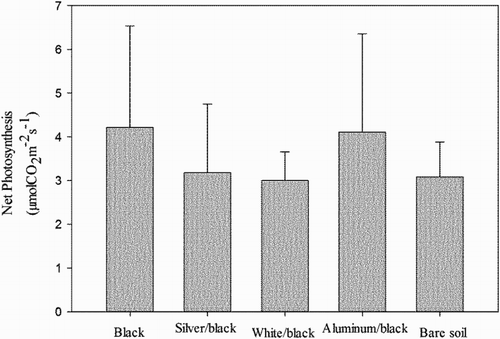
Table 3. Maximum, minimum and mean soil temperature at ten-cm soil depth, under plastic films of different color, in pickling cucumber crop.
Yield
Plastic mulch treatments resulted in higher (p ≤ 0.05) early and total yields in comparison with bare soil, except for the white/black plastic mulch treatment, which rendered similar results (). Such higher yield obtained by using plastic mulch may be due to better soil physical structure, higher nutrient availability, less evaporation of soil water, and higher soil temperature achieved with the mulch as compared to bare soil. Higher yields when using plastic mulches have been found in maize (Zhang et al. Citation2011), watermelon (Andino and Motsenbocker Citation2004), zucchini squash (Summers et al. Citation2004), broccoli (Díaz-Pérez Citation2009) and other crops (Bonanomi et al. Citation2017). The average increase in total yield due to the effect of plastic mulch was 2.05 kg plant−1 (83.7%) (4.50 vs. 2.45 kg plant−1 mulched and bare soil respectively).
Table 4. Early and total yield of pickling cucumber plants cultured in soil mulched with plastic films of different color.
Our results provide evidence that pickling cucumber plants achieve higher growth and increased yield when grown in plastic mulch, and this effect was associated with mean soil temperature. Since treatments using colored plastic mulches may present different behaviors in different environments (Kwabiah Citation2003), we recommend a careful selection of the plastic mulch color to be used in growing pickling cucumber.
Disclosure statement
No potential conflict of interest was reported by the authors.
Notes on contributors
Dr Vicente Torres-Olivar has a postdoc position in the Department of Agroplasticultura at the Centro de Investigación en Química Aplicada, Saltillo, Coah, México. Currently, he is working in the field of plant nutrition and production of vegetable crops under greenhouses and open field conditions.
Dr Luis Ibarra-Jiménez is a professor-researcher in the Department of Agroplasticultura at the Centro de Investigación en Química Aplicada, Saltillo, Coah, México, since 1980 until now. His research is oriented to vegetable production and physiology, especially with Solanaceous and Cucurbit species, including plastic mulches, row covers/tunnel, high tunnels, and shade house conditions. He has published 60 refereed articles.
Dr Antonio Cárdenas-Flores is Associate Professor at the Centro de Investigación en Química Aplicada, Saltillo, Mexico. He received his Ph.D. in Agronomical Sciences and Biological Engineering from the Université Catholique de Louvain, Belgium. His current work is focused on biofertilizers, plant nutrition and quality of fresh produce, especially coupled to agroplasticulture.
Dr Ricardo Hugo Lira-Saldivar has obtained a Ph.D. in the subject of Ecology from the University of California, Davis in the USA. Presently, he is serving as Senior Researcher and Full Professor in the Department of Agroplasticultura belonging to the Research Center for Applied Chemistry (CIQA) at Saltillo, Coahuila, Mexico. He has published 39 research papers and seven books related to agriculture and plant physiology. Currently, he is involved in research with agro nanotechnology and sustainable agriculture under open field and protected conditions.
Dr José Humberto Valenzuela-Soto is a fellow researcher at the National Council for Science and Technology (CONACYT) in the Department of Agroplasticultura at the Centro de Investigación en Química Aplicada, at Saltillo, México. His research on plant biotechnology is mainly oriented to plant–pathogen and plant–insect interactions; biocontrol by plant growth-promoting rhizobacteria in open field and greenhouse conditions.
Dr Marco Antonio Castillo-Campohermoso is Associate Professor at the Research Center in Applied Chemistry, Saltillo, Mexico. He has obtained a Ph. D. in Advanced Techniques in Research and Agricultural and Food Development from the Polytechnic University of Cartagena, Spain. His current work is focused on industrial desert crops in open field and agroplasticulture Management.
ORCID
Luis Ibarra-Jiménez http://orcid.org/0000-0002-2070-756X
References
- Andino JR, Motsenbocker CE. 2004. Colored plastic mulches influence cucumber beetle populations, vine growth, and yield of watermelon. HortScience. 39:1246–1249.
- Bonanomi G, Chirico GB, Palladino M, Gaglione SA, Crispo DG, Lazzaro U, Sica B, Cesarano G, Ippolito F, Sarker TC, et al. 2017. Combined application of photo-selective mulching films and beneficial microbes affects crop yield and irrigation water productivity in intensive farming systems. Agr Water Manage. 184:104–113. doi: 10.1016/j.agwat.2017.01.011
- Díaz-Pérez JC. 2009. Root zone temperature, plant growth and yield of broccoli [Brassica oleracea (Plenck) var. italica] as affected by plastic film mulches. Sci Hort-Amsterdam. 123:156–163. doi: 10.1016/j.scienta.2009.08.014
- Díaz-Pérez JC. 2010. Bell pepper (Capsicum annum L.) grown on plastic film mulches: effects on crop microenvironment, physiological attributes, and fruit yield. HortScience. 45:1196–1204.
- Díaz-Pérez JC, Batal KD. 2002. Colored plastic film mulches affect tomato growth and yield via changes in root-zone temperature. J Am Soc Hort Sci. 127:127–135.
- Díaz-Pérez JC, Phatak SC, Giddings D, Bertrand D, Mills HA. 2005. Root zone temperature, plant growth, and fruit yield of tomatillo as affected by plastic film mulch. HortScience. 40:1312–1319.
- Ham JM, Kluitenberg GJ, Lamont WJ. 1993. Optical properties of plastic mulches affect the field temperature regime. J Amer Soc Hort Sci. 118:188–193.
- Hou XY, Wang FX, Han JJ, Kang SZ, Feng SY. 2010. Duration of plastic mulch for potato growth under drip irrigation in an arid region of Northwest China. Agric For Met. 150:115–121. doi: 10.1016/j.agrformet.2009.09.007
- Ibarra-Jiménez L, Zermeño-González A, Lozano-del Río J, Cedeño Rubalcava B, Ortega Ortiz H. 2008. Changes in soil temperature, yield and photosynthetic response of potato (Solanum tuberosum) under colored plastic mulches. Agrochimica. 52:263–272.
- Kwabiah AB. 2003. Performance of silage corn (Zea mays L.) in a cool climate ecosystem: effects of photodegradable plastic mulch. Can J P Science. 83:305–312. doi: 10.4141/P02-131
- Lamont WJ. 2005. Plastics: Modifying the microclimate for the production of vegetable crops. HortTechnology. 15: 477–481.
- León MJM, Sepúlveda JG. 2012. El daño por oxidación causado por cobre y la respuesta antioxidante de las plantas. Interciencia. 37:805–811.
- López-Tolentino G, Ibarra-Jiménez L, Méndez-Prieto A, Lozano-del Río AJ, Lira-Saldivar RH, Valenzuela-Soto JH, Torres-Olivar V. 2017. Photosynthesis, growth, and fruit yield of cucumber in response to oxo-degradable plastic mulches. Acta Agr Scan B-S. 67:77–84.
- Lovelli S, Pizza S, Caponio T, Rivelli AR, Perniola M. 2005. Lysimetric determination of muskmelon crop coefficients cultivated under plastic mulches. Agr Water Manage. 72:147–159. doi: 10.1016/j.agwat.2004.09.009
- Mahajan G, Sharda R, Kumar A, Singh KG. 2007. Effect of plastic mulch on economizing irrigation water and weed control in baby corn sown by different methods. Afr J Agric Res. 2:19–26.
- Manrique LA. 1995. Mulching in potato systems in the tropics. J Plant Nut. 18:593–616. doi: 10.1080/01904169509364926
- Martin-Closas L, Bach MA, Pelacho AM. 2006. Biodegradable mulching in an organic tomato production system. In XXVII International Horticultural Congress-IHC2006: International Symposium on Sustainability through Integrated and Organic. 767: p. 267–274.
- Ruiz-Machuca LM, Ibarra-Jiménez L, Valdez-Aguilar LA, Robledo-Torres V, Benavides-Mendoza A, Cabrera-De La Fuente M. 2015. Cultivation of potato–use of plastic mulch and row covers on soil temperature, growth, nutrient status, and yield. Acta Agr Scan B-S. 65:30–35.
- Summers CG, Mitchell JP, Stapleton JJ. 2004. Management of aphid-borne viruses and Bemisia argentifolii (Homoptera: Aleyrodidae) in zucchini squash by using Uv reflective plastic and wheat straw mulches. Environ Entomol. 33:1447–1457. doi: 10.1603/0046-225X-33.5.1447
- Tarara JM. 2000. Microclimate modification with plastic mulch. HortScience. 35:169–180.
- Zhang S, Li P, Yang X, Wang Z, Chen X. 2011. Effects of tillage and plastic mulch on soil water, growth and yield of spring-sown maize. Soil Till Res. 112:92–97. doi: 10.1016/j.still.2010.11.006
- Zhou LM, Li FM, Jin SL, Song Y. 2009. How two ridges and the furrow mulched with plastic film affect soil water, soil temperature and yield of maize on the semiarid Loess Plateau of China. Field Crop Res. 113:41–47. doi: 10.1016/j.fcr.2009.04.005

